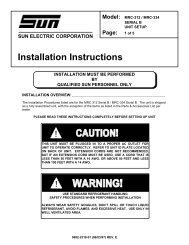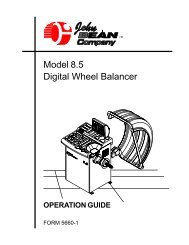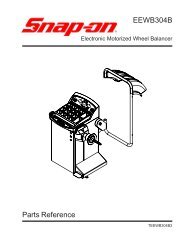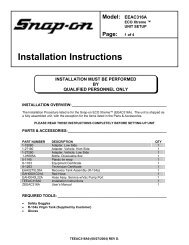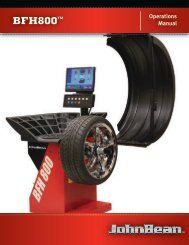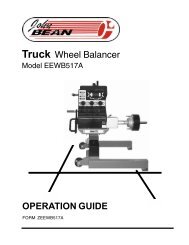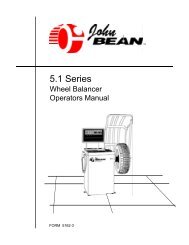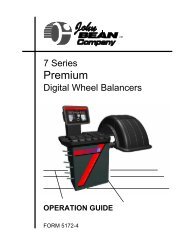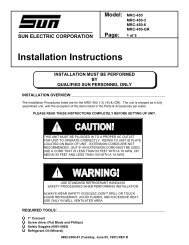700 Series Disk and Drum Lathe Operators Manual - Snap-on ...
700 Series Disk and Drum Lathe Operators Manual - Snap-on ...
700 Series Disk and Drum Lathe Operators Manual - Snap-on ...
You also want an ePaper? Increase the reach of your titles
YUMPU automatically turns print PDFs into web optimized ePapers that Google loves.
C. Place <strong>on</strong>e face plate over arbor.<br />
Install spring <str<strong>on</strong>g>and</str<strong>on</strong>g> centering c<strong>on</strong>e.<br />
D. Place drum over the centering<br />
c<strong>on</strong>e <str<strong>on</strong>g>and</str<strong>on</strong>g> follow with the other face<br />
plate <str<strong>on</strong>g>and</str<strong>on</strong>g> necessary spacers to fill<br />
arbor past mounting surface. Install<br />
arbor nut <str<strong>on</strong>g>and</str<strong>on</strong>g> tighten by h<str<strong>on</strong>g>and</str<strong>on</strong>g>. This<br />
will center the drum between the face<br />
plates.<br />
E. Tighten arbor nut snugly with spanner<br />
wrench. If drum touches housing,<br />
place a spacer <strong>on</strong> arbor between inner<br />
face plate <str<strong>on</strong>g>and</str<strong>on</strong>g> arbor shoulder.<br />
NOTE: If you experience hard spots<br />
when machining fr<strong>on</strong>t <str<strong>on</strong>g>and</str<strong>on</strong>g> rear drums,<br />
turn motor off, slow the speed <str<strong>on</strong>g>and</str<strong>on</strong>g><br />
finish the cut. If the finish is objecti<strong>on</strong>able,<br />
discard the drum.<br />
Figure 15<br />
Rear drum mounted<br />
using 90526 floating<br />
drum attachment<br />
Operating <str<strong>on</strong>g>Lathe</str<strong>on</strong>g><br />
1. The Model <str<strong>on</strong>g>700</str<strong>on</strong>g> Combinati<strong>on</strong> <str<strong>on</strong>g>Drum</str<strong>on</strong>g><br />
<str<strong>on</strong>g>and</str<strong>on</strong>g> Disc <str<strong>on</strong>g>Lathe</str<strong>on</strong>g> is equipped with a<br />
c<strong>on</strong>trol lever <strong>on</strong> the carriage. This<br />
c<strong>on</strong>trol lever must be in the drum<br />
positi<strong>on</strong> to machine a brake drum.<br />
See Figure 16.<br />
NOTE: When Turning drums, the<br />
rotor feed rate selector dial should be<br />
in the OFF positi<strong>on</strong>. This step saves<br />
wear <strong>on</strong> the DC motor.<br />
2. Depending <strong>on</strong> width of drum, advance<br />
carriage assembly toward the<br />
drum by turning carriage traverse h<str<strong>on</strong>g>and</str<strong>on</strong>g><br />
wheel clockwise, until left side of carriage<br />
is approximately <strong>on</strong>e-half inch<br />
bey<strong>on</strong>d the end of lathe housing.<br />
3. Move cross slide to its innermost<br />
positi<strong>on</strong> <str<strong>on</strong>g>and</str<strong>on</strong>g> then back off by turning<br />
dial wheel five turns (about 1/2") counterclockwise.<br />
Loosen nut <str<strong>on</strong>g>and</str<strong>on</strong>g> adjust<br />
tool post holder, tool bar, <str<strong>on</strong>g>and</str<strong>on</strong>g> cutter<br />
assembly to approximate drum diameter.<br />
Tighten nut <str<strong>on</strong>g>and</str<strong>on</strong>g> leave feed shift<br />
lever in neutral (N) positi<strong>on</strong>. See<br />
Figure 17.<br />
Figure 17<br />
Tighten<br />
4. Loosen two square head set screws<br />
<strong>on</strong> tool post holder <str<strong>on</strong>g>and</str<strong>on</strong>g> move cutter<br />
<str<strong>on</strong>g>and</str<strong>on</strong>g> tool bar into brake drum until it<br />
touches back of drum. While tightening<br />
set screws, rock tool bar clockwise<br />
<str<strong>on</strong>g>and</str<strong>on</strong>g> counterclockwise until set<br />
screws tighten <strong>on</strong> flat surfaces. Cut-<br />
ter tip should extend from tool bar no<br />
more than 3/4" when turning a typical<br />
brake drum. Some small drums may<br />
require less cutter extensi<strong>on</strong>. See<br />
Figure 18.<br />
5. Turn lathe <strong>on</strong> <str<strong>on</strong>g>and</str<strong>on</strong>g> advance carriage<br />
by turning traverse h<str<strong>on</strong>g>and</str<strong>on</strong>g> wheel<br />
until cutter is at the extreme back of<br />
drum. Advance cutter into braking<br />
surface to be machined by turning<br />
micrometer dial wheel counterclockwise.<br />
C<strong>on</strong>tinue turning dial wheel until<br />
desired depth of cut is obtained.<br />
NOTE: Micrometer dial wheel reading<br />
indicates the amount of metal removed<br />
from diameter of drum (not radius).<br />
6. Tighten adjusting knob <strong>on</strong> side of<br />
carriage. Engage feed lever in either<br />
rough or finish cut, depending <strong>on</strong> the<br />
c<strong>on</strong>diti<strong>on</strong> of the drum surface to be<br />
machined.<br />
NOTE: When machining a barrel<br />
shaped or worn drum, the outer edge<br />
(open end) of drum usually has a<br />
smaller diameter than the center secti<strong>on</strong><br />
where the brake shoe exerts the<br />
most wear. The smaller diameter<br />
area (outer edge) must be machined<br />
first before making the finish cut. See<br />
Figure 19.<br />
Some drums may have a deep groove<br />
or grooves (usually .020" or less) that<br />
Figure 19<br />
Move c<strong>on</strong>trol<br />
lever to drum<br />
posit<strong>on</strong><br />
1/2"<br />
Tighten<br />
can be machined in <strong>on</strong>e pass. When<br />
this c<strong>on</strong>diti<strong>on</strong> exists, move cutter to<br />
bottom of deepest groove <str<strong>on</strong>g>and</str<strong>on</strong>g> note<br />
micrometer dial reading. Turn dial<br />
wheel to remove cutter from groove<br />
Figure 16<br />
Figure 18<br />
10



